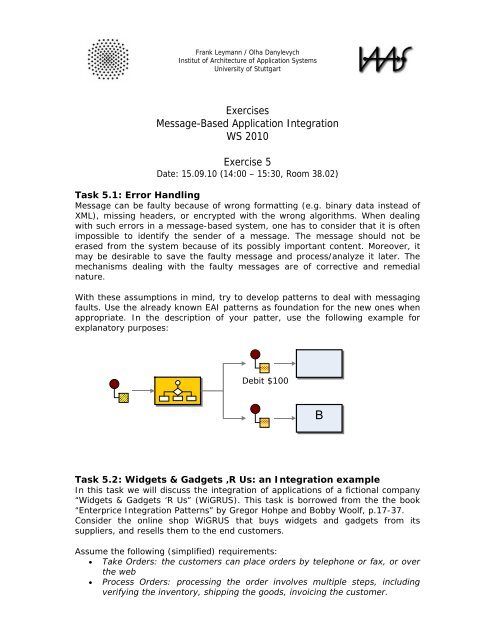Exercises Message-Based Application Integration WS 2010 ... - IAAS
Exercises Message-Based Application Integration WS 2010 ... - IAAS
Exercises Message-Based Application Integration WS 2010 ... - IAAS
Create successful ePaper yourself
Turn your PDF publications into a flip-book with our unique Google optimized e-Paper software.
Frank Leymann / Olha Danylevych<br />
Institut of Architecture of <strong>Application</strong> Systems<br />
University of Stuttgart<br />
<strong>Exercises</strong><br />
<strong>Message</strong>-<strong>Based</strong> <strong>Application</strong> <strong>Integration</strong><br />
<strong>WS</strong> <strong>2010</strong><br />
Exercise 5<br />
Date: 15.09.10 (14:00 – 15:30, Room 38.02)<br />
Task 5.1: Error Handling<br />
<strong>Message</strong> can be faulty because of wrong formatting (e.g. binary data instead of<br />
XML), missing headers, or encrypted with the wrong algorithms. When dealing<br />
with such errors in a message-based system, one has to consider that it is often<br />
impossible to identify the sender of a message. The message should not be<br />
erased from the system because of its possibly important content. Moreover, it<br />
may be desirable to save the faulty message and process/analyze it later. The<br />
mechanisms dealing with the faulty messages are of corrective and remedial<br />
nature.<br />
With these assumptions in mind, try to develop patterns to deal with messaging<br />
faults. Use the already known EAI patterns as foundation for the new ones when<br />
appropriate. In the description of your patter, use the following example for<br />
explanatory purposes:<br />
Debit $100<br />
B<br />
Task 5.2: Widgets & Gadgets ‚R Us: an <strong>Integration</strong> example<br />
In this task we will discuss the integration of applications of a fictional company<br />
“Widgets & Gadgets ‘R Us” (WiGRUS). This task is borrowed from the the book<br />
“Enterprice <strong>Integration</strong> Patterns” by Gregor Hohpe and Bobby Woolf, p.17-37.<br />
Consider the online shop WiGRUS that buys widgets and gadgets from its<br />
suppliers, and resells them to the end customers.<br />
Assume the following (simplified) requirements:<br />
• Take Orders: the customers can place orders by telephone or fax, or over<br />
the web<br />
• Process Orders: processing the order involves multiple steps, including<br />
verifying the inventory, shipping the goods, invoicing the customer.
• Check Status: customers can check the status of the order.<br />
• Change Address: customers can use a Web front-end to change their<br />
billing and shipping address.<br />
• New Catalog: suppliers update their catalog periodically. WiGRUS needs to<br />
update its pricing and availability on the basis of the new catalogs.<br />
• Announcements: customers can subscribe to selective announcements<br />
from WiGRUS.<br />
• Testing and Monitoring: the operations staff needs to be able to monitor<br />
all individual components and the message flows between them.<br />
Consider each of these requirements separately and create a solution using the<br />
EAI pattern language.
















